Sofrito Vs Mirepoix: The Difference Between These Mixtures
If your kitchen repertoire consists of even a few dishes, you've likely made a version of either sofrito or mirepoix. Both mixtures are made of finely chopped vegetables cooked in fat to concentrate and build flavor. Most often a dish will start with either a sofrito or mirepoix, which provides the foundational flavor and aromas on which the rest of the recipe is built. Sauces, soups, gravies, curries, meat, and seafood dishes all use a version of these mixtures.
Most countries' cuisines also have a version of sofrito or mirepoix made from varying ratios of ubiquitous ingredients like onion, carrots, bell peppers, and local aromatics. While they have several parallels, there are significant differences between sofrito and mirepoix, and they're not generally interchangeable because of how fundamental they are to a dish's flavor and aroma. While mirepoix is always cooked at the beginning, sofrito can sometimes come later in the recipe, usually as a punchy, aromatic topping over grilled meats and seafood.
Sofrito's origins lie in medieval Spanish cuisine while mirepoix is a relatively recent French culinary creation from the 18th century that gets its name from the French town of the same name. Mirepoix was introduced by the chef of an aristocrat who established the onion-carrot-celery recipe. Sofrito is a staple in European, Mediterranean, Caribbean, and Latin American cuisines, while mirepoix remains the mainstay of any kitchen serving up classical Western dishes with roots in French cuisine.
Sofrito is a versatile mixture with ancient Spanish roots
Called soffritto in Italy, recaito in Puerto Rico, and sofregit in the 14th-century Catalan cookbook that contains its first known mention, sofrito has countless variants across continents and cannot be limited to just one recipe. The Spanish iteration of sofrito uses olive oil to lightly fry onion, garlic, peppers, and tomatoes. When colonists brought the cooking technique to Latin America, it was localized and remains a crucial aspect of the region's varied cuisines. In Puerto Rico, local herbs and sweet chilies are added to sofrito. Meanwhile, the Italian version (soffritto) uses onions, carrots, celery, garlic, and various aromatics and herbs depending on the recipe.
In the U.S., sofrito is often used in Caribbean cuisine, and Southern classics like gumbo, and is made with onion, green bell pepper, and celery. The ingredients for a sofrito are generally finely chopped or minced. You can also make an easy sofrito using the blender and save yourself most of the grunt work. Fry the chopped ingredients in olive oil on medium-low heat until lightly browned and soft. From here, the sofrito can be added to a recipe or used to build a dish.
Mirepoix comes from classic French cuisine
Mirepoix is the flavor foundation of innumerable classic sauces, soups, and broths and uses a simple mix of onion, carrot, and celery. Prepping mirepoix is a right of passage that most culinary students go through as finely cutting vegetables without mistakes into equal-sized pieces is a core skill required in any kitchen. Mirepoix is also lightly fried in oil, butter, or animal fat until the vegetables sweat and soften, building and concentrating flavor. Some dishes require the mirepoix to be strained out before serving, while others, like a bolognese, let the soft vegetables add to the dish's texture.
Because of its roots in classic French cuisine, mirepoix ingredients are not as fluid across geographies as those used in sofrito. Traditional mirepoix is made from two parts onion and one part each of carrot and celery. It's best to cut the vegetables evenly so they cook uniformly. So if you want to feel like a pro, you can easily sharpen your kitchen knife to fine-dice the mirepoix ingredients. Apart from looking impressive, smaller pieces cook faster and build deeper flavor. The flavor of both mirepoix and sofrito is intended to melt into the dish, and though you won't taste either mixture specifically, a dish that's delicious is likely built on a well-made mirepoix or sofrito.


